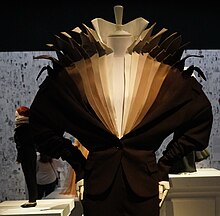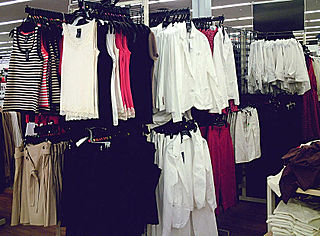
Ready-to-wear (RTW) – also called prêt-à-porter, or off-the-rack or off-the-peg in casual use – is the term for garments sold in finished condition in standardized sizes, as distinct from made-to-measure or bespoke clothing tailored to a particular person's frame. In other words, it is a piece of clothing that was mass produced in different sizes and sold that way instead of it being designed and sewn for one person. The term off-the-peg is sometimes used for items other than clothing, such as handbags. It is the opposite of haute couture.

Wearable art, also known as Artwear or "art to wear", refers to art pieces in the shape of clothing or jewellery pieces. These pieces are usually handmade, and are produced only once or as a very limited series. Pieces of clothing are often made with fibrous materials and traditional techniques such as crochet, knitting, quilting, but may also include plastic sheeting, metals, paper, and more. While the making of any article of clothing or other wearable object typically involves aesthetic considerations, the term wearable art implies that the work is intended to be accepted as an artistic creation or statement. Wearable art is meant to draw attention while it is being displayed, modeled or used in performances. Pieces may be sold and exhibited.

Jean Paul Gaultier is a French haute couture and prêt-à-porter fashion designer. He is described as an "enfant terrible" of the fashion industry and is known for his unconventional designs with motifs including corsets, marinières, and tin cans. Gaultier founded his eponymous fashion label in 1982, and expanded with a line of fragrances in 1993. He was the creative director for French luxury house Hermès from 2003 to 2010, and retired following his 50th-anniversary haute couture show during Paris Fashion Week in January 2020.

A fashion week is a week-long fashion industry event where fashion designers, brands, or "houses" display their latest collections in runway fashion shows to buyers and the media which influences upcoming fashion trends for the current and approaching seasons.
Raf Jan Simons is a Belgian fashion designer. Beginning in furniture design, Simons launched his own menswear label in 1995. He was creative director at Jil Sander (2005–2012), Christian Dior (2012–2015), and Calvin Klein (2016–2018). As of 1 April 2020, he is the co-creative director of Prada, in partnership with Miuccia Prada.

Paris Fashion Week is a series of designer presentations held semi-annually in Paris, France, with spring/summer and autumn/winter events held each year. Dates are determined by the Fédération de la Haute Couture et de la Mode. Paris Fashion Week is held at venues throughout the city.
Ralph Rucci is an American fashion designer and artist. He is known in particular for Chado Ralph Rucci, a luxury clothing and accessories line. Rucci's clothing designs have appeared in a number of major exhibitions, and he has won some significant fashion-industry awards. He is the subject of a recent documentary, and he and his clothing have received positive critical response in the fashion press.
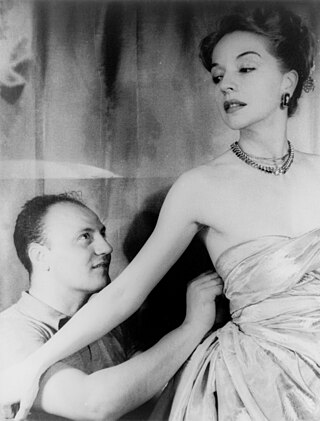
Haute couture is the creation of exclusive custom-fitted high-end fashion design. The term haute couture is French, "haute" meaning "high" or "elegant," and "couture" translating to "sewing" or "dressmaking." The term haute couture generally refers to a specific type of upper garment common in Europe during the 16th to the 18th century, or to the upper portion of a modern dress to distinguish it from the skirt and sleeves. Beginning in the mid-nineteenth century, Paris became the centre of a growing industry that focused on making outfits from high-quality, expensive, often unusual fabric and sewn with extreme attention to detail and finished by the most experienced and capable of sewers—often using time-consuming, hand-executed techniques. Couture translates literally from French as "dressmaking", sewing, or needlework and is also used as a common abbreviation of haute couture and can often refer to the same thing in spirit.
Ma Ke is a Chinese fashion designer. She has two clothing labels: EXCEPTION de Mixmind, a ready-to-wear line started in 1996 and retailed in China; and WUYONG, an haute couture line founded in 2006. In 2007, Ma Ke starred in the award-winning documentary Useless by Chinese director Jia Zhangke. In 2008, her fashion house WUYONG was appointed as a Guest member of the Chambre Syndicale de la Haute Couture in France.
Edita Vilkevičiūtė is a Lithuanian supermodel. Throughout her whole career, she has appeared in 25 Vogue covers. In 2015, she was one of the highest paid models in the world thanks to the frangrace ads for Roberto Cavalli and Viktor & Rolf.
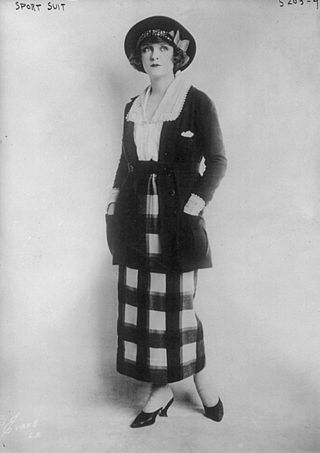
Sportswear is an American fashion term originally used to describe separates, but which since the 1930s has come to be applied to day and evening fashions of varying degrees of formality that demonstrate a specific relaxed approach to their design, while remaining appropriate for a wide range of social occasions. The term is not necessarily synonymous with activewear, clothing designed specifically for participants in sporting pursuits. Although sports clothing was available from European haute couture houses and "sporty" garments were increasingly worn as everyday or informal wear, the early American sportswear designers were associated with ready-to-wear manufacturers. While most fashions in America in the early 20th century were directly copied from, or influenced heavily by Paris, American sportswear became a home-grown exception to this rule, and could be described as the American Look. Sportswear was designed to be easy to look after, with accessible fastenings that enabled a modern emancipated woman to dress herself without a maid's assistance.

Stephen Jones OBE is a British milliner based in London, who is considered one of the most radical and important milliners of the late 20th and early 21st centuries. He is also one of the most prolific, having created hats for the catwalk shows of many leading couturiers and fashion designers, such as John Galliano at Dior and Vivienne Westwood. His work is known for its inventiveness and high level of technical expertise. Jones co-curated the 2009 exhibition Hats: An Anthology for the Victoria and Albert Museum.

Jasper Garvida is a fashion designer. Born in the Philippines, he grew up in Canada before moving to London to study Fashion Design at Central St. Martins College of Art and Design. He established his eponymous fashion label in September 2008, known for its bold, highly embellished womenswear. Jasper has swiftly established his reputation as a unique luxury designer with an emphasis on tailoring and feminine silhouettes.

The House of Worth was a French fashion house that specialized in haute couture, ready-to-wear clothes, and perfumes. It was founded in 1858 by English designer Charles Frederick Worth. It continued to operate under his descendants until 1952 and closed in 1956. The House of Worth fashion brand was revived in 1999.

Laura Yumi Lambert is a Belgian model.
Maison Margiela, formerly Maison Martin Margiela, is a French luxury fashion house founded by Belgian designer Martin Margiela and Jenny Meirens in 1988 and headquartered in Paris. The house produces both haute couture-inspired artisanal collections and ready-to-wear collections, with the former influencing the designs of the latter. Product lines include womenswear, menswear, jewellery, footwear, accessories, leather goods, perfumes and household goods. Known for deconstructive and avant-garde designs with unconventional materials, Maison Margiela has traditionally held live shows in unusual settings, for example empty metro stations and street corners. Models' faces are often obscured by fabric or long hair to direct attention to the clothes and design. Margiela resigned as creative designer in 2009 and John Galliano was appointed to the role in 2014.

Guo Pei is a Chinese fashion designer. She is best known for designing dresses for Chinese celebrities, and in America for Rihanna's trailing yellow gown at the 2015 Met Gala. Guo is the first born-and-raised Asian designer to be invited to become a guest member of the Chambre Syndicale de la Haute Couture. In 2016, Time listed her as one of the World's 100 Most Influential People.

Luvanis S.A. is a private investment company headquartered in Luxembourg and specialized in the incubation and revival of long-dormant luxury brands, also coined as “sleeping beauties”.
Heavenly Bodies: Fashion and the Catholic Imagination was the 2018 high fashion art exhibition of the Anna Wintour Costume Center, a wing of the Metropolitan Museum of Art (MMA) which houses the collection of the Costume Institute.
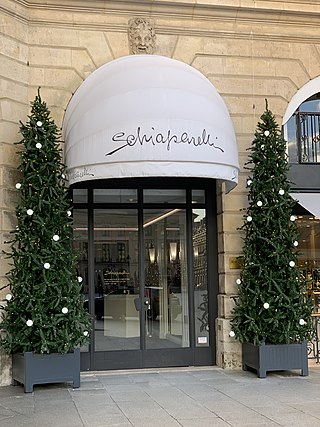
Maison Schiaparelli is a haute couture house created by avant-garde Italian fashion designer Elsa Schiaparelli in 1927, and moving towards luxury ready-to-wear after being bought in 2007 by Diego Della Valle. The house is famous for its eccentric fashions, the use of Surrealism in its collections, its sense of humour, the "shocking Pink" color, gender crossing, and its use of human anatomy depictions, among other unconventional themes.


